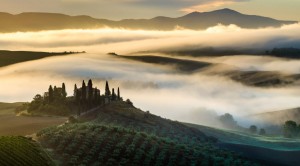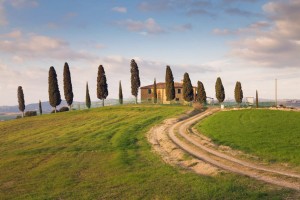A new era began in the Val d’Orcia region when the city state Siena defeated the feudal house of Aldobrandeschi. Siena didn’t only expand its capital – rapidly and vastly – it also placed great emphasis on the representative nature of the agricultural hinterland. The Val d’Orcia was altered and enhanced on an expansive level during its period of populating in the 14th and 15th century in order to find the perfect mix of aesthetic scenery and idealised governance. The Val d’Orcia inspired numerous Renaissance artists to create astonishing landscape paintings and remains a popular travel destination to this very day. Even the UNESCO acknowledged the uniqueness of this region and declared it World Heritage Site in 2004.
History of the Val d’Orcia

©Bigstock.com/MikeMareen
The Val d’Orcia has been crossed ever since Roman times being a part of the Via Cassia, the road connecting Rome to Tuscany, before gaining added significance as a stage of the Via Francigenia and being a preferred stopover point during pilgrimages from Francia to Rome. The big reshaping, however, as already mentioned, only began when the city state Siena took over. Corsignano grew to become Pienza in the 14th and 15h century, the magnificent co-cathedral Santa Maria Assunta was built. Successive expansions of the other main villages in the valley – Castiglione d’Orcia, Montalcino, Radicofani and San Quirico d’Orcia – were set in motion as well.
You cannot rate the city state’s importance for the fine arts highly enough. It goes without saying that the Sienese School of painting benefitted the most from the patrons and sponsors. During the Renaissance and the subsequent incorporation into the Grand Duchy of Tuscany, the Val d’Orcia turned into a popular destination for painters from all over country. The region blossomed even more during Medici rule, mostly due to improved infrastructure of both the Via Cassia and the Via Francigenia. Numerous artists captured the attractive composition of cone-shaped hills and wide, agricultural areas on their canvasses. The harmony of man and nature became a popular leitmotif.
Trip to Pienza
You might’ve already read our blog on the historic centre of Pienza, which was named UNESCO World Heritage Site in 1996. As such, we will keep things short and sweet, but there are a few highlights in this charming little planned town you absolutely shouldn’t miss:
- Santa Maria Assunta: There are no two ways about it – the Cathedral of Pienza is the architectural masterpiece of the Val d’Orcia n. Renaissance art and northern-alpine Gothic meet characteristic Tuscan order. Master builder Bernardo Rosselino knew fairly little about the strict architectural rules of the Gothic period resulting in a more than appealing clash of styles from the façade to the interior.
- Palazzo Pubblico: Originally built solely for representative reasons – Pienza needed a town hall in order to maintain its town status – this small palace acts as a sort of bridge between the religious and the secular parts of Piazza Comunale.
- Palazzo Piccolomini: Breathtakingly beautiful Renaissance ideals line the courtyard. A walk through the atrium with its garden and the arcade simply never ceases to amaze.
- Palazzo Vescovile: Pope Pius II had originally planned to accommodate visiting bishops here. The palace now houses several museums. Among the exhibits are religious artefacts, paintings from the 12th to the 15th century and regional textile works.
Other villages in the Val d’Orcia
You’re probably already more than familiar with Pienza, but what about the other four villages in the Val d’Orcia? We just have to share their beauty with you:
- Castiglione d’Orcia: This sleepy little village is situated on a hill and can be seen from afar. Originally a major stage on the Via Francigenia, you still get to experience its original medieval beauty and numerous narrow alleys and small squares. Park at the Parco della Rimembranza just outside the village centre and enjoy the great clear view from the chapel on the park hill. The Pieve dei Santi Stefano e Degna used to house major works by Lorenzetti and Vecchietta, which are currently shown in the Pinacoteca of Siena.
- Montalcino: Montalcino used to be surrounded by an enormous 13th and 14th century wall with six gates, many parts of which still exist at least in parts. Add the huge castle into the mix and you get an idea of the monumental dimensions of the original fortifications. Things are a bit more leisurely these days with delicious honey being produced in the surroundings. Look forward to checking out the Duomo di Montalcino and another nine churches throughout the village.
- Radicofani: Originally carrying great significance as a stopover on pilgrimages and a fortification to Siena, the fortress of Radicofani was completely destroyed in April 1555. The ruins have since been turned into an awesome museum with an astonishing 360° panoramic view of the surrounding mountains and hills – that’s something you should certainly check out! Furthermore, we highly recommend a trip to the Pieve San Pietro with various works from 15th and 16th century artists.
- San Quirico d’Orcia: This village with its vast agricultural fields, where wild asparagus is grown, and countless churches and chapels is located in the heart of the Val d’Orcia. The 12th century Collegiata church stands tall amidst the many medieval buildings. High Gothic elements, hybrid beasts, which are highly unusual for Italian art, and knot columns on the façade and the portals highlight different construction phases. Inside you’ll marvel at the abundance of paintings and frescoes, such as the stunning “Madonna col Bambino in Trono e quattro Santi” by Renaissance painter Sano di Pietro.
Sporty and delicious holidays

©Bigstock.com/alexino
Are you looking for some variety? Would you like to experience something different between your trips to the scenic villages of the Val d’Orcia? This region is a dream come true for hikers and bikers with its wide plains and several climbs, some of which can be quite challenging. We highly suggest passing on longer tours on particularly hot and sunny days as the valley offers very little shade. Don’t miss out on stops in Bagni San Filippo and Bagno Vignoni in spring and autumn. Warm thermal spring water will soothe aching muscles get your motor running again. The Val d’Orcia is an important pecorino region as well. You can buy the popular hard cheese in several stages of maturity. You should also try a plate of Pici (thick, hand-rolled spaghetti with a savoury side) or a hearty serving of Ravioli con Ricotta (filled pancakes, optionally with meat and/or oven-baked with cheese).
The Val d’Orcia clearly is a must-visit destination during your next holiday in Tuscany. You’ll certainly fall under the spell of this unique region with its scenic beauty, captivating sports offerings and many a stunning village. We suggest setting aside two or three days for the Val d’Orcia next time you’re in Florence in Siena. It’ll definitely be worth it!